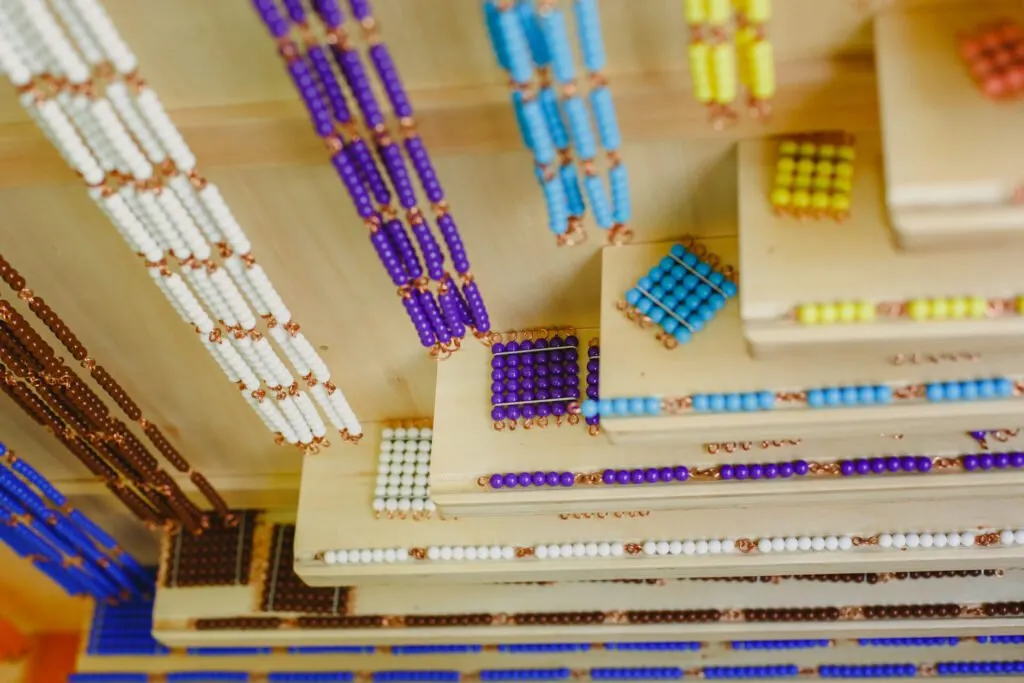Will they see numbers in color?

Montessori Math
I visited my son's classroom one evening for an event covering the lower elementary Montessori curriculum. What I saw was unlike the curricula I used to write as an educator or any that I experienced as a student.
A Montessori curriculum is built upon materials that we can see and touch, often from wood. The materials are used as both exercises and conversation pieces to teach fundamental understandings.
When I arrived in the classroom the materials were laid out in a ring circling the center of the room. My son's teacher sat on the ground and demonstrated how some of the math materials are used to add, subtract, and multiply.
Math and numbers are a breathtaking abstraction. When we add 1+1 it does not matter if we are adding rocks, apples, or people. The answer is always 2 . This abstraction is ever-present in the Montessori math curriculum. Numbers are beads. Beads can be touched. We can see big numbers are comprised of many beads. They take time to assemble. They are hard to hold in our hands. The numerical digits we use 1, 2, 3... with their seemingly arbitrary shapes, offer no such reminder of the physical nature of numbers.
Place value and scale recur again and again. Often the relative position of a bead means that it is worth 10 of its neighbor beads on the right. This is an unintuitive concept for young children but is a prerequisite for understanding with any specificity the ideas of "multiple" and "many." To a person without this foundation there is no difference between 100 and a 1,000 - both are too many to count on one's fingers.
And then there is color. Groupings of beads have different colors. A single bead representing the number one is always red. Two green beads grouped together on a piece of wire symbolize the 2. Pink for three, yellow for four and so on.

And there is game-like repetition. Many of the fundamental operations in math are riffs on the same combinatorial actions. Adding a five and six digit number is not that different from adding two digit numbers together. And with the materials, multiplying millions with tens of millions are within reach of even a first grader. And even if the vastness of one million is lost on the six-year-old, repeating the steps of adding and multiplying single digits together builds fluency. Extended focus on a single problem is an incredible feat for a youngster - but a common occurrence in a Montessori classroom.
Some of my limits of my mathematical intuition are the result of how I was taught math as a child. When I add numbers I see digits in my head. For the longest time when adding 9 to another number I used a strange algorithm indeed. Subtract one from the number being added to nine and take the resulting difference and put it behind a one.
9 + 7 = ?
7 - 1 = 6
Put the 6 behidn a 1.
16When I multiply, I recite multiplication tables in my head - often to the tune of a 90s Disney song, which is how I was taught them in fourth grade. To this day 8 x 8 sometimes computes to 63 in my head just because it fits the tune to my ear better than 64.
But, what if I had had years of practice adding one red bead and two green beads to make three pink beads? And having swapped five light blue beads and four yellow beads for nine dark blue beads hundreds of times, would thirty years later I see in my mind's eye, not Arabic numerals, but colors?
And so my hope is that one day, when my children wrestle with 9+7, they will see nine dark blue beads, seven white beads and intuitively know the answer is 16.
Member discussion